 |
 |
||||||||||||||
President’s symposium
New Thinking About Children
Presidential inauguration week, in October 2011, was marked by brilliant displays of Tufts talent, oratory, and regalia. But given the new president’s stature as a scientist, it seemed fitting that there should also be a quieter, more scholarly event: a meeting of minds on the subject of child development. Anthony Monaco, Tufts’ thirteenth president, wanted to prove the value of having different disciplines train their sights on the same topic—an approach that is likely to become more and more common in these parts. Accordingly, Peggy Newell, provost and senior vice president ad interim, organized the first-ever inaugural symposium, advances in child development. The speakers included Monaco, himself a specialist in the genetics of developmental disorders, and one of his U.K. mentors, Sir Michael Rutter. They were joined by half a dozen top scientists from different schools of Tufts. Topics ran the gamut from dyslexia to tooth decay. Herewith, a digest of the talks, the full titles of which are given after each speaker’s name.
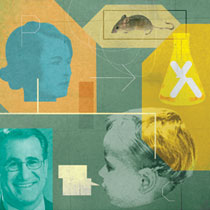 |
When Genes Go Awry
It’s long been known that developmental disorders run in families, but pinpointing genetic culprits is no small task. Monaco and his laboratory have taken several quite different approaches. To track down the genes associated with autism, for example, they homed in on chromosome abnormalities that occur when cells divide, causing breaks in genes or changes in their number, for example by deleting a copy. Scrutinizing those chromosome abnormalities turned up single genes, or sometimes a group of genes, that influence susceptibility to autism in fifteen to twenty percent of cases.
In another case, involving a family with a rare speech and language disorder, Monaco and his colleagues narrowed the cause down to a single gene, FOXP2. An abnormality in that gene could signal whether a member of the family would inherit the language problem, even before any symptoms appeared. By studying the FOXP2 gene in songbirds, mice, and monkeys, the researchers gained insights into the gene’s role in vocalizations throughout evolution and how language developed in humans. “It’s allowed us at least one entry point to start to dissect the biological pathways inside the brain involved in speech and language,” Monaco said.
Dyslexia is another neurodevelopmental disorder with a genetic component. Monaco’s team managed to identify one of four genes apparently associated with the disorder. Studies show that the gene affects how neurons form in the fetal brain. It “might be involved in the correct adherence and migration of neurons,” Monaco said.
With all of these disorders, early detection can be key to improving outcomes. The contributions Monaco and other genetics researchers are making to the field eventually could lead to screening techniques that would improve diagnosis and give doctors better insight into potential treatments.
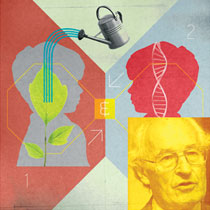 |
Nature and Nurture
It’s an old debate: heredity versus environment. Which of the two exerts the greater influence on the individual has proved to be even more complicated than once believed, according to Rutter. While psychiatrists have fixated on either biological or environmental causes of mental disorders, most such conditions now appear to stem from a complex interplay between the two.
Many of the newer findings have come from “natural experiments,” studies that compare naturally occurring groups so as to isolate genetic effects—the children of twins, for example, or children born of artificial insemination versus children of donated eggs. Previously, some clinical studies suggested that ADHD or antisocial behavior may be caused by a mother’s smoking during pregnancy—an environmental factor, in other words. But these newer studies have shown that children with certain genetic profiles suffer no such ill effects from their mothers’ smoking, although there is an effect on birthweight. In those cases, genes trump environment.
Sometimes, the opposite seems to be true. Childhood depression was long thought to be genetically determined, but new studies show that environmental factors are twice as important as genetic predisposition in determining whether a child is diagnosed with the disease. In some cases, genes and environment can have a multiplier effect, exponentially increasing the chances of developing certain disorders. In still other cases, environmental forces can be canceled out by genetics. A variant of one particular gene, for instance, affects the vulnerability of children experiencing maltreatment, helping them develop resiliency.
All of these findings have dramatic implications for treatment—allowing better targeting of certain disorders. But first, Rutter said, doctors must abandon their old notions of nature or nurture in favor of a more individualized approach that sees the two as inseparable.
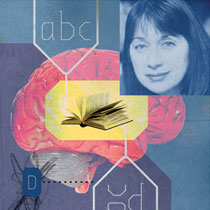 |
Rewiring Dyslexia
To most of us, reading seems such a basic brain function that we hardly stop to think about how we learned to do it. In fact, said Wolf, human beings aren’t born with any inherent ability to read text. Rather, we all jury-rig unrelated parts of our brain—those in charge of visual recognition of shapes, phonological recognition of sounds, and higher cognitive functions for comprehension and syntax—into a complex circuitry that decodes the sentence you are reading now in a matter of milli-seconds. “Each new reader,” Wolf said, “must create an entire reading circuit”—usually between ages five and seven. “It took us two thousand years as a species to get to an alphabet,” she said, referring to the evolution from symbolic writing such as hieroglyphics or cuneiform to the first real phonetic writing system, developed by the Greeks around 800 B.C. But a child must go through a similar cognitive evolution in just “two thousand days.”
It’s no wonder that this complicated process sometimes goes haywire, causing reading disorders. Brain scans have shown that many dyslexic children fail to activate areas in the left hemisphere for phonological skills that help in sounding out letters; instead they use areas in the right hemisphere keyed to visualization. Wolf and her colleagues have devised ways to rewire those faulty pathways. Putting children through a special curriculum that breaks down each stage of the reading process into specific techniques, mimicking the sequence of activities in the brain, the researchers have seen marked improvement in both word recognition and reading comprehension.
Her latest studies look at how the daily bombardment of technology is affecting children’s reading development. “Is that going to be changing the degree to which they possess the deep reading skills?” she asked. In other words, how will all of the circuitry we’ve created for computers affect the circuitry we’ve created in our brains?
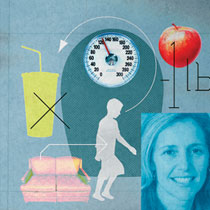 |
Growing Up, Not Out
Everybody talks about childhood obesity. Economos has dedicated herself to actually doing something about it. A decade ago, she helped put together a community research study in Tufts’ home base of Somerville. Shape Up Somerville has since become a national model. Aimed at getting children to eat healthier foods and increase physical activity, the program used a “systems” approach, tackling all sides of the obesity issue at once. Parents plotted walking routes to schools, the schools switched to healthier menus, and doctors were trained in more effective screening for obesity. Even local restaurants got in on the act, offering smaller portions.
After the first year, the study showed a drop in obesity that translated into about a pound per child per year compared with two neighboring towns—a significant amount over childhood. “It’s exactly what we hoped for,” said Economos. When Michelle Obama recently launched a national campaign to combat childhood obesity, she singled out Shape Up Somerville for praise. Economos is now developing a national “playbook” for tackling the problem, recognizing that just as there is no one cause for the obesity epidemic, so there is no one-size-fits-all solution.
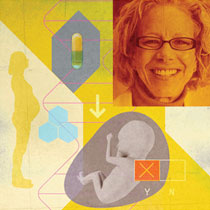 |
Treat the Fetus
The joy of a new pregnancy is often overshadowed by The Test—routine prenatal screening for Down syndrome. If the result is positive, the parents must choose whether to continue or terminate the pregnancy. Bianchi is working on a third option: treating the condition in the womb. Her lab has been looking for drugs that, given to the pregnant woman, might counteract some of the biochemical abnormalities seen in Down fetuses. Examining RNA that floats in the amniotic fluid, Bianchi and her team found that genes in such fetuses are affected by something called oxidative stress—a byproduct of oxygen metabolism that creates destructive chemicals. The researchers plugged the gene expression profiles of the affected fetuses into a database of all FDA-approved drugs, searching for any that might stop the oxidative effects.
Sure enough, several drugs popped up. In early results, one of the drugs greatly reduced oxidative stress in cells from Down fetuses in the test tube. Now Bianchi’s team is experimenting with mice. “To the best of our knowledge, this is the first time anyone has tried to use a gene expression rationale for treating a genetic condition in utero,” Bianchi said. If it works, the same techniques could be used to treat other birth defects, perhaps opening up a whole new field: prenatal pediatrics.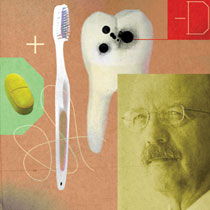 |
Vitamins for Teeth
The most common disease of childhood isn’t asthma or diabetes. It’s early childhood caries, more commonly known as tooth decay. By age five, some twenty-five percent of affluent children show some signs of the disease—caused by bacteria that turn sugar into acid, which breaks down the enamel on the teeth. Among poor children, however, the disease is epidemic, affecting sixty percent of them by age five. Some children get signs of decay before their first birthday. “This disease shows no age limitations,” said Thomas.
While many studies have examined the role of sugar or improper bottle feeding in causing cavities, Thomas has focused on a less intuitive cause, deficiency of vitamin D, a problem that particularly affects poor communities due to inadequate nutrition. Experimenting with mice that can’t metabolize vitamin D, Thomas has shown dramatic differences in their tooth enamel compared to ordinary mice. Surprisingly, the teeth of mutant mice form their enamel coating faster than normal. The trouble is, the enamel is weak. In ordinary mouse enamel, there’s a strong crystalline structure—“a beautiful prism arrangement,” as Thomas called it (he displayed an electron microscope image of what looked like a wall made of neat rows of bricks). By contrast, the teeth of the mutant mice exhibited a “significant disruption of that crystal.” In preliminary tests, acid dissolved the D-starved enamel much faster than the normal enamel.
While the research doesn’t discount the importance of limiting sugar and good old brushing and flossing to control cavities, it does point to another dimension of teeth care that dentists should start to address.
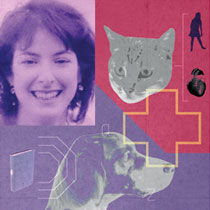 |
Learning from Animals
“You may be wondering why you have a veterinarian talking to you on a symposium on child development,” said Freeman. “It all boils down to the idea of One Health.” It’s the proposition that studying animals can yield insights into the treatment of human disorders, including developmental ones. The concept has been championed by Tufts and by Freeman in her research on animal nutrition.
One disease that affects both animals and humans is hypertrophic cardiomyopathy (HCM)—a heart condition that can cause sudden cardiac death in young athletes. Maine coon cats have a genetic mutation that renders them more susceptible to the disease, and Freeman has studied them intensively. An intriguing finding: some cats with the mutation get very sick and others not at all. Why? Possibly because of differences in nutrition, Freeman said.
In all sorts of animals, malnourishment during early development can interfere with important processes like DNA repair and cell growth cycles. “Low birth weight in children can increase the risk for coronary heart disease and hypertension in later life,” Freeman said. The research on HCM could open up new treatment methods both for cats and for humans.
Sometimes pets play a therapeutic role for humans. People who want to shed pounds, for example, are more successful if they are also trying to help their tubby dog or cat lose weight. Pets can even help children learn to read. “Dogs are nonevaluative, nonjudgmental listeners,” Freeman said. “So children who lack confidence or lack reading skills are very comfortable reading to dogs.” Freeman and her colleagues found that second-graders who read to dogs became better and more dedicated readers than those who read to other people. There is no word yet on how this affected the literacy of the dogs.
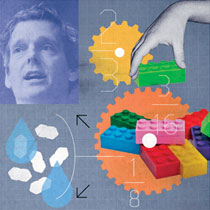 |
Building Scholars
A local first-grade teacher gave her pupils Lego blocks, gears, and a mechanical motor, and asked them to make a snowplow to push styrofoam packing peanuts out of the way. Most of the kids aced the assignment. But then she made the peanuts heavier by soaking them in water. Now only a few kids, those who had used geared wheels for more power, succeeded. “All of a sudden,” Rogers recounted, “they were really interested in what gears were.”
That hands-on lesson is typical of the way Rogers and his outreach team teach mechanical and mathematical principles to young children. They set a goal, encourage as many routes to that goal as possible, and then let kids keep trying until they succeed.
When kids learn with their hands, they retain more. Children who learned fractions from a blackboard did just as well on a math test as those who learned fractions by programming a Lego robot car to travel different distances. But tested again six weeks later, the Lego kids remembered almost twice as much as the blackboard kids.
Such methods aren’t easy to integrate into a classroom geared to standardized tests, so Rogers and the center have developed teaching tools, training programs, and online communities to help teachers adopt the techniques. Ultimately, of course, he’d be happy if standardized tests favored creative problem-solving. “If we can try and get as much variation in the solutions as possible, instead of one right answer,” he said, “then I think we’ve succeeded.”
MICHAEL BLANDING, who often writes for this magazine, is a Senior Fellow at the Schuster Institute for Investigative Journalism at Brandeis University and a Fellow at Harvard's Edmond J. Safra Center for Ethics. He recently authored a book of investigative nonfiction, The Coke Machine: The Dirty Truth Behind the World's Favorite Soft Drink (Avery/Penguin).